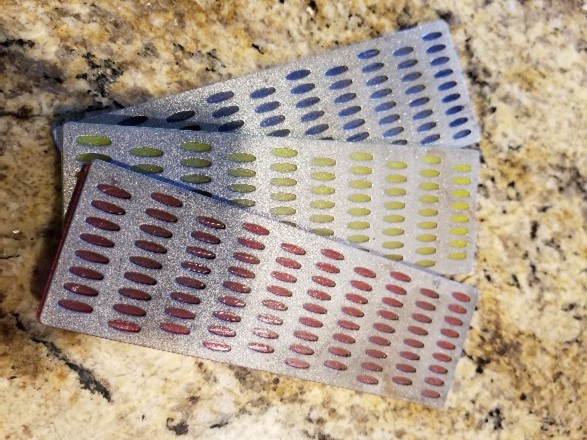
by Stan Logan | Aug 3, 2021 | Garden tools
I love to sharpen tools—mainly because it’s so easy, but of course also because a sharpened tool works so much better. Years ago, my go-to sharpeners were a metal file and a whetstone. About 20 years ago, I discovered the angle grinder that was fantastic at sharpening larger tools and lawn mower blades. I have given a lot of demonstrations using a triangular file to sharpen garden tools, and that file is still the best for repairing pruner and lopper blades that have nicks. When a power source is available, a Dremel with a barrel stone can quickly remove a lot of metal if necessary. Several years ago, I favored the carbide sharpening tool that Corona puts out. Its main advantage is that it is so portable, but it requires knowing the technique of how to use it.
Today, my favorite sharpening tool is the diamond file. It has to be the easiest of all these tools to use. It behaves like a layer of sandpaper glued to a flat surface. You simply lay it on the surface to be removed and move it about. You can use a circular motion or straight-lined motion—it doesn’t matter—whereas a file has to be moved in a straight line forward only. Then too, a diamond file will work on hardened steel, whereas a metal file simply slips across the surface and the cutting edges of the file are ruined. Today I was at an iris dig where I was able to sharpen all the scissors that were being used. Now, the diamond file does not remove a lot of metal, so you wouldn’t want to use it for large tools like axes or shovels. But lighter tools like pruners, loppers, and household items like scissors and knives are so easily sharpened. The only challenge is holding the diamond file at an angle so that it matches the beveled edge to want to grind away. You can see if the angle is correct by where the metal turns shiny. The entire beveled surface should start to become shiny as you work.
You can test the sharpness of the tool by pulling your thumb across (not along) the sharpened edge. When the edge is sharp, it will grab your skin rather than just slip across it.
Amazon carries a great variety of diamond files, but most are narrow. For our sharpening needs, a large, flat file surface is best. I really like the files shown below which I bought at Harbor Freight. Having 3 different grits is very beneficial, and as far as I know, diamond files don’t wear out.
I really think you will appreciate your tools more when they are sharp, and diamond files make it such an easy and rewarding process.
Stan, The Tool Man
P.S. You will really appreciate your sharpened tool when you cut yourself. A sharp tool will damage fewer nerve cells and your cut will be practically painless. By the way, I have found that Shout prewash is really good at removing blood stains from clothing.

Diamond Files
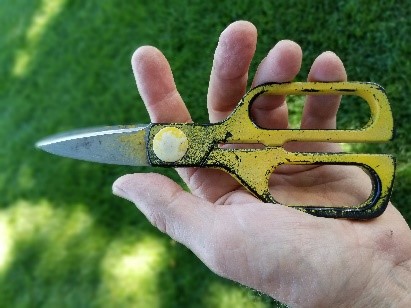
by Stan Logan | Aug 1, 2021 | Garden tools
Have you ever asked yourself, “Why, of all the tools I own, do I most often lose the one tool that I value the most?” The answer, of course, is the reason that tool is most valued is because you use it the most. That point was brought to bare a couple days ago at the WPA Rock Garden. It was past noon and we were planning to leave when Marcia couldn’t find her Hori Hori knife. She found it several minutes after searching. It was laying on a wall in the shade and the dark blue handle did little to make it visible.
My suggestion to you is that you buy a can of yellow spray paint and apply it to that tool of yours that you are always losing. Now, granted, this application will not make its appearance more esthetic, but it will make it more easy to spot in that unexpected location where you chose to leave it. Case in point: the scissors pictured below are uglier than sin, but since I sprayed them with yellow paint, I haven’t lost it once. Then too, you never have to worry about someone stealing your tool when it looks like crap. I’m just sayin’.
Stan, The Loser Man

P.S. I would not suggest this technique for your gloves.
P.P.S. We went to Annie’s yesterday, and guess what LaVille bought? . . . a pair of yellow gloves.
P.P.P.S. Has anyone seen my phone?
by Stan Logan | Jun 30, 2021 | Fertilizer, Garden tools
I know you may not be willing to admit it, but I know there is a chance that you have Jobe’s fertilizer spikes. I can understand your reluctance to fess up considering the presentations that have been given by the perennial club. In June you heard a program on composting in which the use of chemical fertilizers was discouraged. Not too long ago, Pam Bone told you the uselessness of driving fertilizer spikes around trees because so little area of the root zone was affected. So, what are you doing to do with these things other than let the box continue to collect dust amongst your garden supplies? Well, let me tell you:
First of all, do you have the spikes for “beautiful evergreens” (16-4-4) or for “lush fruit & nut trees” (10-15-15)? This obviously will determine where fertilizer will be applied.
Second, do you have a hammer? If so, this is what you should do. Lay out a spike on a hard surface and beat it with the hammer. Your sidewalk out front may be a good place. You may gather a curious crowd of neighbors, who will immediately scurry off to seek out their own dusty box of fertilizer spikes. Now, you will find that bits and pieces of fertilizer will fly about and wearing googles is advised. It adds interest to the spectacle too.
Finally, apply the broken-up fertilizer bit to your plants. Now, here’s what I do with our citrus trees. I break the spikes into 4 pieces. I gather them into a bucket and walk amongst the trees and toss the chunks around the drip line of the trees so that whole ground area is evenly covered. I then take my hammer and bash them down into the soil. I time the application so that the soil is moist and soft, but not so moist that walking about compresses the soil. There is a pretty good layer of bark covering the ground, but I just smack the chucks down through it. I have to admit that I find this procedure rather enjoyable.
If you are applying the fertilizer to plants around your yard or potted plants, you will want to break up the spikes into much smaller pieces as I have shown in the photo. I used the chisel, but that isn’t necessary. LaVille has found it to be affective to shove small chunks down the sides of pots. You will have to decide how small the chunks should be and how much to apply, but then that’s the challenge, right?
So, what are you going to do with the mess of powdered fertilizer dust left on your sidewalk? Sweep it up and scatter it around your garden. On second thought, perhaps your front sidewalk is not the ideal hammering area as you wouldn’t want any fertilizer to end up in the gutter and on to our rivers and streams. You should probably do your spike bashing in the back yard. That way no one will think you are too cheap to buy a proper fertilizer.
But Stan, you say, why did you buy fertilizer spikes? Estate sales—I cannot resist a bargain. You would be surprised to see how many estate sales have dusty old boxes of unopened fertilizer spikes. Don’t let that happen at your estate sale.
Stan, The Hammer Man
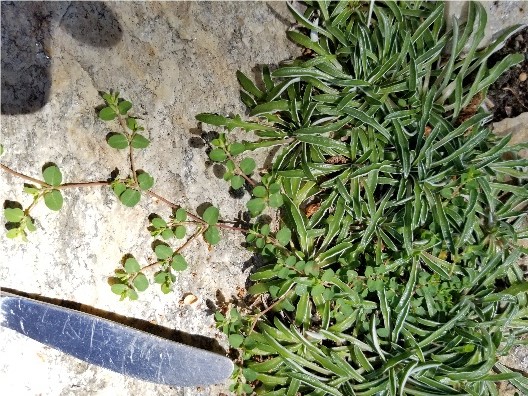
by Stan Logan | Jun 26, 2021 | Garden tools, Weeds
Somehow it is ironic—instead of me describing a tool that I feel you need, but don’t have, here is a tool that you do have, but probably don’t need. Unless you have steadfastly held onto the eating habits of your Neanderthal ancestors, I’m betting that you have at least one set of eating utensils in your home. It is the dinner knife that I am singling out this time. I have found that this is the best tool for teasing out weeds from ground cover. Now, if you don’t have ground cover, stop reading and go out to your garden and do something useful—take a flashlight if it is dark.
Since you are still reading, you must have ground cover . . or are just too pooped to crawl out to the garden again. Now the term “teasing” is a biological dissection term for the act of carefully separating the organs of small specimens with pointed tools like probes or dissecting needles. Every time I use a dinner knife to tease a weed out of desired ground cover plants, I cannot help but be reminded of my first biology dissection where I cut through the dorsal surface of a preserved earthworm and teased through the connective tissue until I found the two lobed brain and the nerve cords that led down and around the pharynx. Hmmm . . . you don’t have those same memories
Back to the garden: The way you use your knife to tease is to grab the offending weed and pull gently while you work the knife down into the root area and move it about. If you are successful, the weeds will be extracted and the ground cover will remain intact. If you are unsuccessful, the stem of the weed will break off only to regrow when you aren’t looking. Now I will be the first to admit that this is not a pleasant gardening chore. You are on you hands and knees with you nose to the ground (not literally). Even using knee pads does not appease my knees which insist on complaining for hours afterwards.
I have included 3 examples of weeding that recently required teasing in my garden. I always refer to the ground cover plants as conspiring plants as they seem to delight in hiding offensive weeds until they grow into maturity.
You know, if using grandma’s sterling dinner knife seems disrespectful, drop by a thrift store and pick up a strong stainless steel model, but watch out for impulse buying!
Stan, The Tool Man
 |
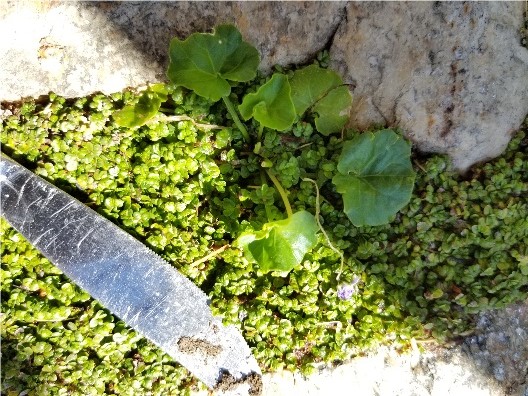 |
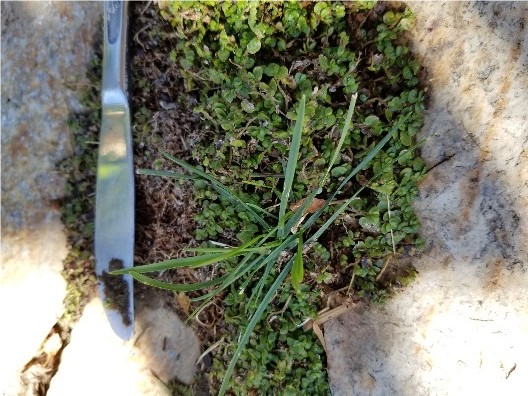 |
| Spurge in Dimondia |
Australian violets in baby tears |
Grass in baby tears |

by Stan Logan | Jun 20, 2021 | Butterflies
Today (June 16) my wife is thrilled. Caterpillars are eating her passion vines. Not only that—the adults are doing a little dance to spread their pheromones. Soon there will be Gulf Fritillaries all over the back yard. If you are interested in attracting butterflies to your yard, your best chance is to grow either Passiflora caerulea or Passiflora edulis in your garden. Many other passion vines are not attractive to this butterfly, especially those with red flowers.
LaVille will not have vines available at the upcoming Fall sale, but if you are eager, you can come over to the house and she can give you cuttings to give you a head start on next Spring’s growth. I suggest you come early while there is still plant material left over from voracious larval munching (just kidding).
Stan, The Happy Husband

Caterpillar on Passion Vine
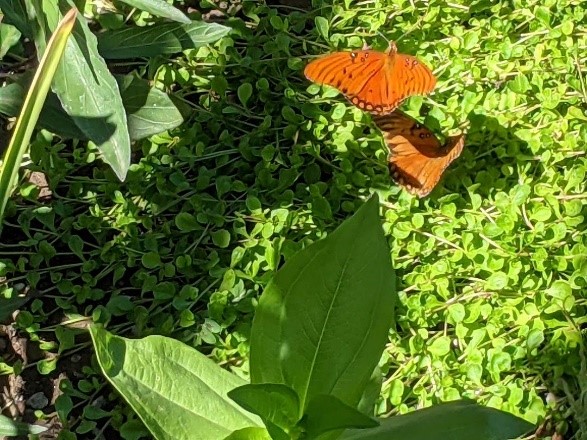
Gulf Fritillaries








